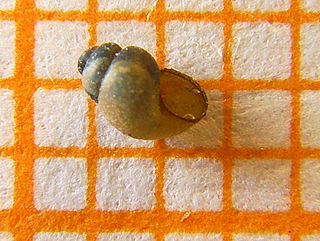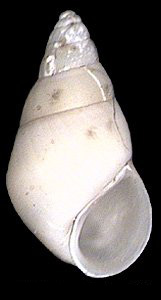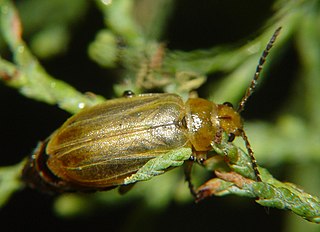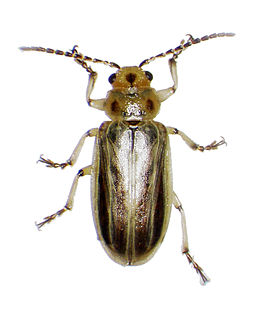
The genus Tamarix is composed of about 50–60 species of flowering plants in the family Tamaricaceae, native to drier areas of Eurasia and Africa. The generic name originated in Latin and may refer to the Tamaris River in Hispania Tarraconensis (Spain).

Bythinella is a genus of very small freshwater snails, an aquatic gastropod mollusk in the family Bythinellidae.
Bythinella carinulata is a species of very small freshwater snail, an aquatic gastropod mollusk in the family Amnicolidae. This snail is endemic to France.

Hydrobia is a genus of very small brackish water snails with a gill and an operculum, aquatic gastropod mollusks in the family Hydrobiidae.

Diorhabda elongata is a species of leaf beetle known as the Mediterranean tamarisk beetle (MTB) which feeds on tamarisk trees from Portugal and Algeria east to southern Russia. The MTB is used in North America as a biological pest control agent against saltcedar or tamarisk, an invasive species in arid and semi-arid ecosystems.

Diorhabda carinata is a species of leaf beetle known as the larger tamarisk beetle which feeds on tamarisk trees from Ukraine, eastern Turkey and Syria east to northwest China, Kyrgyzstan and Pakistan, extending as far south as southern Iran. It is used in North America as a biological pest control agent against saltcedar or tamarisk, an invasive species in arid and semi-arid ecosystems.

Diorhabda sublineata is a leaf beetle known as the subtropical tamarisk beetle (STB). The species was first described by Hippolyte Lucas in 1849. It feeds on tamarisk trees from Portugal, Spain and France to Morocco, Senegal, Algeria, Tunisia, Egypt, Yemen, and Iraq. It is used in North America as a biological pest control agent against saltcedar or tamarisk, an invasive species in arid and semi-arid ecosystems.

Diorhabda meridionalis is a species of leaf beetle known as the southern tamarisk beetle (SoTB) which feeds on tamarisk trees from Syria to western and southern Iran and southern Pakistan. The SoTB may have potential for use in North America as a biological pest control agent against saltcedar or tamarisk, an invasive species in arid and semi-arid ecosystems.

Eucyclotoma carinulata is a species of sea snail, a marine gastropod mollusk in the family Raphitomidae.

Eucyclotoma is a genus of sea snails, marine gastropod mollusks in the family Raphitomidae.
Pareumenes is an Afrotropical, Palearctic and Oriental genus of potter wasps.

Neoponera is a genus of ants in the subfamily Ponerinae. Restricted to the Neotropics, the genus is found from southern Texas to southern Brazil. Workers are slender, and medium to large in size (6.5–19 mm); queens are similar to workers but larger and winged.
Anerpa is a genus of longhorn beetles of the subfamily Lamiinae, containing the following species:
Anerpa steinkae is a species of beetle in the family Cerambycidae. It was described by Karl-Ernst Hüdepohl in 1990.
Pterolophia carinulata is a species of beetle in the family Cerambycidae. It was described by Stephan von Breuning in 1938.
Acallepitrix is a genus of flea beetles in the family Chrysomelidae. There are more than 20 described species in Acallepitrix. They are found in the Neotropics, Central America, and North America.

Pseudosermyle is a genus of walkingsticks in the family Diapheromeridae. There are more than 20 described species in Pseudosermyle.
Doldina is a genus of assassin bugs in the family Reduviidae. There are about eight described species in Doldina.
Evaniella is a genus of ensign wasps in the family Evaniidae. There are more than 70 described species in Evaniella.

Membracis is a genus of treehoppers in the family Membracidae. There are more than 50 described species in Membracis.











